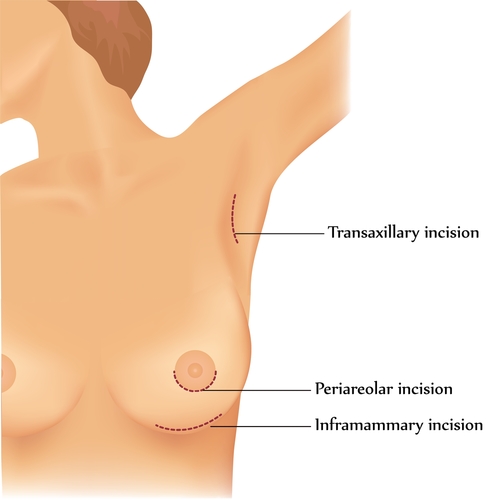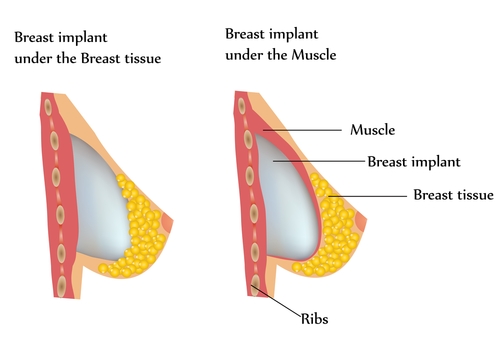Breast augmentation is a type of cosmetic surgery that has been popular for almost forty years. Also known as an augmentation mammoplasty, a breast augmentation or enhancement procedure is designed to restore, correct, and/or improve the size, shape, and feel of the patient’s breasts. Although there are other methods of breast enhancement available, the most common approach involves the surgical insertion of prosthetic breast implants. While breast augmentation via implant is often an elected procedure, mammoplasties are also used extensively in a reconstructive fashion, to treat burn victims, cancer patients, and other such persons.
BREAST IMPLANTS – There are two basic types of implants that can be used for breast augmentation surgeries: silicone implants and saline implants. Implants filled with other materials, though once used in the past, are no longer manufactured today, due largely to issues of substandard quality.
Silicone Breast Implants – Silicone breast implants have been available since the 1960s, and today’s models show a huge improvement over older varieties. Whereas more dated silicone devices featured a liquid silicone inside of a sack (or envelope), current models employ a more solid silicone gel, which has greatly reduced the incidents of leakage and rupture.
Saline Breast Implants – Saline breast implants are similar in function to those made of silicone, but differ somewhat in design. Unlike silicone implants, which are surgically inserted in their proper form, saline implants are actually installed empty, to be filled with the desired amount of saline solution only once they are secured in place. This allows the cosmetic surgeon to make a much smaller incision than would be required for a silicone implant of comparable size. On the downside, saline breast implants are less effective in women with smaller cup-sizes, reduced breast tissue, or with significant reconstruction needs – who can all benefit from the greater support offered by the silicone gel varieties.
Aside from the choice of implant, breast augmentation surgery is defined by two variables, incision type and implant placement, which affect both the style of procedure and range of results.
INCISION TYPES:
 Inframammary – The inframammary incision is made on the underside of the breast, along the inframammary fold. This location allows for a longer incision with full access, but the trade-off is a more noticeable scar.
Inframammary – The inframammary incision is made on the underside of the breast, along the inframammary fold. This location allows for a longer incision with full access, but the trade-off is a more noticeable scar.
Periareolar – The periareolar incision is made around the edge of the areola. The opening that is produced is only about five centimeters long, which makes silicone implants difficult. Also, because of the proximity to milk ducts and nipple nerves, this type of cut can also be more risky.
Transaxillary – The transaxillary incision is cut into the armpit, thus keeping any post-surgical scarring well out of view; however, since the implants must be slid into place from the patient’s sides, there can be greater symmetry and balance problems with this incision than with others.
Transumbilical – The transumbilical incision is cut at the navel, with the implants then being inserted through a gap about two centimeters wide. Needless to say, this opening will be too small for silicone implants, and (although the chest is kept scar-free) positioning can be somewhat of a challenge.
Transabdominal – The transabdominal incision is extremely similar to the transumbilical, only it is generally used when a breast augmentation is being performed at the same time as an abdominoplasty, or tummy tuck.
IMPLANT LOCATIONS:
Subglandular – In this case, the implant is secured in the retromammary space – behind the breast tissue and in front of the pectoralis major.
Subfascial – Here the breast implant is secured behind the fascia of the pectoralis major. There is still active debate as to what exactly this accomplishes, but the argument is that the extra layer of tissue provides better coverage and support.
Subpectoral – In a subpectoral surgery, the breast implant is situated beneath the pectoralis major, but the inferior muscular connections are released, allowing the implant to straddle the subglandular plane. While this positioning achieves significant coverage, the implant is often less secure, and will occasionally shift more than one might like.
Submuscular – In this case the surgeon uses the same placement location as in the subpectoral instance – beneath the pectoralis major – only the lower muscular attachments remain in place. With some minor suturing, a breast implant in this location can achieve maximum coverage and also remain secure.

Though some incision types will heal more quickly than others, full recovery from a breast augmentation will take several weeks. Occasionally, post-surgical complications will arise, and your doctor may need to perform corrections or revision work after the initial surgery. As was mentioned before, there are less intensive procedures (such as lipo-injection and mastopexy) which have also proven successful in breast enhancement, so it is good idea to consider all of the options, and to discuss any questions or concerns with a licensed professional, before making a decision.
If you have any more questions, or if you would like to get in touch with a highly rated cosmetic surgeon in your area, call 1-800-IDEAL-YOU and talk one-on-one with an expert.

